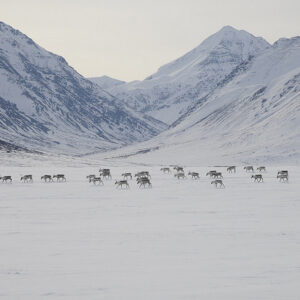
Ambler road rears its head
A Canadian mining company wants Alaska to finance a private industrial road in the Brooks Range of northern Alaska and the State intends to lead the charge through the Alaska Industrial Development and Export Authority. The Ambler road rears its head again after former Gov. Bill Walker released funds to complete the project’s environmental review before leaving office in November.

Gates of the Arctic National Park and Preserve in spring. Photo by Zac Richter, NPS.
The proposed 220-mile road would skirt rural villages and connect the “Ambler Mining District” with the Dalton Highway and Fairbanks, going through state and tribal lands and Gates of the Arctic National Park and Preserve.
It would be essentially a 200-plus-mile long driveway subsidized by the State of Alaska to benefit an undercapitalized Canadian mining company.
Interior communities oppose the road
Many of the communities that would be most impacted by the road and mine oppose the project because of the risk of industrial contamination and the impact on access to traditional hunting and fishing grounds.
Numerous communities and groups have passed resolutions in opposition, including nine tribes: the Native Village of Allakaket, the Native Village of Alatna, the Native Village of Rampart, the Kobuk Traditional Council, Huslia Tribal Council, Evansville Tribal Council, Ruby Tribal Council, and Louden Tribal Council (Galena), and Native Village of Kotzebue.

The Western Arctic Caribou Herd on its annual migration through Gates of the Arctic National Park and Preserve. Photo courtesy of Lisa Oakley
Evansville, Inc., the City of Bettles, the City of Ambler, and Tanana Chiefs Conference, a nonprofit consortium of 42 federally recognized tribes from Interior Alaska, also passed resolutions against the project. The Western Arctic Caribou Herd Working Group also recently voted 17-1 to oppose the road.
Millions spent on BLM’s Environmental Impact Statement
Before leaving office, Gov. Bill Walker released $3.6 million to complete the Environmental Impact Statement—money he had put on hold when first in office because of the state’s financial crisis. Now, with a new Governor in office, one who told mining companies that Alaska was now “open for business,” the Alaska Industrial Development and Export Authority and the Bureau of Land Management intend to quickly push through the project.
AIDEA has presented a proposal to permit, finance and construct the 220-mile, $300-million road through publicly funded bonds, and claims it can pay it back through tolls from companies exploring and mining for copper and other precious metals.
The proposed project is a boondoggle in the making. AIDEA’s proposal fails to safeguard the lands, waters, wildlife and people of the region, and it fails to substantiate how the state will get paid back.
Inadequate and hasty proposal

Map showing AIDEA’s original proposed route for the road. AIDEA has since rerouted the eastern end of the road. Map by Karen Minot, courtesy of the National Parks Conservation Association.
AIDEA’s proposal lacks details, substantiation, or regard for the people who already live in the area.
The lack of details and thorough analysis in AIDEA’s proposal is pervasive:
- The proposal fails to provide necessary information regarding permafrost and soil conditions in the area or to show how and where mitigation measures will be employed to stabilize permafrost and soil.
- The proposal fails to provide information on dust control for the industrial gravel road.
- The proposal fails to estimate the probability of fuel, chemical, or ore spills, or provide a plan for dealing with them.
- The proposal fails to address water quality, quantity, and other hydrologic impacts to the area.
- The proposal fails to address protecting fish, plant life, wildlife, and marine life, including threatened and endangered species.
- The proposal claims it will provide jobs without recognizing the rural and traditional way of life that does not rely on cash economies and wages.
- The proposal fails to address the impact of industrial activity on hunting, fishing, and the nutrition and health of the people in the region.
- The proposal fails to show that it can safeguard the Western Arctic Caribou Herd, the main source of food and culture for people in the region, or to recognize that a decrease in access to traditional food decreases the quality of life of people in the region and has far-reaching economic, cultural, and other impacts.
Now that BLM has funding, it expects to put out a draft EIS for public review and comment sometime in 2019, possibly in the summer—right when Alaskans from impacted communities will be hunting caribou.


